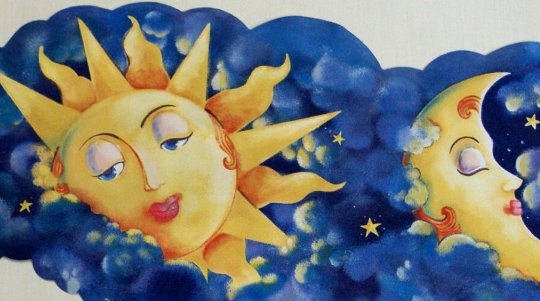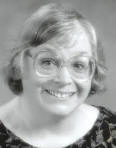
The three most influential factors in a horoscope are generally the Sun, Moon, and Ascendant. Thus they are a good place to begin analyzing a chart. While their weights may be nearly identical in terms of their influence, their functions are different.
The Ascendant, Sun, and Moon tend to work well together when the signs involved are harmonious. An exact aspect makes them work even more smoothly. Signs that are trine fall within the same element ---- earth to water, or fire to air. water to water, air to air, fire to fire, or earth to earth. Signs that are sextile involve complementary elements
The much more difficult combinations are the Sun, Moon, or Ascendant placed within the same sign type or modality -- cardinal to cardinal, fixed to fixed, or mutable to mutable. When in the same modality, they either square or oppose one another and thus tend to work at cross purposes.
Separating Out Their Functions
People with a given Sun, Moon, or rising sign may behave similarly, though the motivation is different. Thus, a Capricorn rising, Capricorn Moon, and Capricorn Sun may all strive for success, but the reasons are different. The Capricorn Moon strives for success in order to make the world a safe place -- literally to ensure a roof over his or her head, and probably Mom's as well, as she grows older. The Capricorn rising may strive for success because of being cast in the role of family hero, the one who will distinguish or legitimize the family through worldly accomplishments. For the Capricorn Sun, success is a requirement for self-worth and its prerequisite -- Dad's approval, however fleeting it may be. (Here, the father's demands for achievement tend to escalate. Where once a single "A" on the report card received a "Well done", the Dean's List soon became a minimum requirement.)
The Sun is the core self, with its functions encompassing most of the words that begin with self -- the sense of self, self-expression, self-confidence, self-esteem, self-worth, self-development, self-sabotage, self-centeredness, and plain old selfishness. The Sun's sign, house, and aspects give us a sense of who we are and are not, and what we are capable of -- in brief, it is our identity. You'd probably be listing your Sun's qualities if you were describing yourself as "I'm the kind of person who...." You may recall the popular song by John Lennon that goes "life is what happens to you while you're busy making other plans." The part that makes those other plans is the Sun.
Most often, it is the father or his equivalents who lend the sense of self and of confidence described by the Sun. In old-time astrology, the Sun represented men, and the Moon, women. In today's world, where more women are developing and expressing their Sun qualities through work and creative pursuits, this is no longer as true. Moreover, I would say women have more freedom and validation to express their solar qualities than men have to express their lunar ones. However, we are in transitional generations where women still have not had maternal career role models often enough, so the rule about the Sun showing the father's influence is still likely to be true.
The Moon is more often than not the imprint of our mothers or mother surrogates. However, with many men now taking over a substantial part of child care, it would be interesting to see how the child's chart reflects that. The Moon represents a part of us that begins to develop in infancy, in our mother's arms, long before we have any verbal capacity. At that age, we do not understand who we are (the Sun) or how we fit into the family (the Ascendant); we only know what we feel -- hunger, heat, cold, dampness, rage, fear, or need. The Moon is our sense of comfort and safety, or the lack thereof. The Sun develops later and is more conscious and verbal. One has to have a sense of self as separate from caretakers before a self-concept can develop.
It is difficult to summarize in a paragraph or two all that the Moon represents -- I've written not one but two entire tomes on the subject.1 We learn much of what the Moon encompasses from our mothers and their equivalents. The programming includes which emotions we are comfortable expressing, what we do to make ourselves feel secure, our model for nurturing ourselves and others, and what kinds of women we surround ourselves with or strive to be.
For instance, a child with a Moon-Saturn aspect or Moon in Capricorn is often born to a mother with one or more of the following characteristics: older, anxious, depressed, overwhelmed with responsibilities, strongly career-oriented. The offspring of women who experience deep postpartum depressions often have placements like these. If the mother is chronically depressed, the infant soaks it up by osmosis, and depression can become an emotional keynote in the child's life well into adulthood. If the mother perpetually worries about financial security and experiences hardship, the child may come to view the world as unsafe and act accordingly.
How the Moon & Ascendant Relate
The observer may have some difficulty separating out the Ascendant from the Moon. Both are imprinted by the family, albeit at slightly different stages of development. The Moon -- the maternal imprint -- happens before the child has enough mental development to know there is a role to be played (the Ascendant), or even before it is entirely clear that the child and mother are two separate beings (the Sun). Before we have words for it, we learn whether the world is a safe place or not. We also soak up our mother's most typical emotions, and they become a predominant theme in our own emotional repertory.
I've spoken of the Ascendant as the role we were trained to play in the family dynamics, showing how we needed to behave in order to survive our early environment. A Gemini-rising individual, for example, might be the family clown, while Pisces rising might be the lost child, and Aquarius can be the rebel.
It seems to me that the Moon and Sun occur earlier in the development of the child than does the Ascendant. In order to grasp the role that family members are training us to play, we need at least a rudimentary social sense. (Bottom line, we first need a sense of ourselves as separate, which is the Sun's domain.) We need to know that each person in the family network has a part to play, and we need some degree of awareness of what our own role is expected to be within that family economy. Although the part we play ultimately becomes more knee-jerk and automatic, this role takes much of our childhood to perfect. The Ascendant, then, is social conditioning and generally conscious, whereas the Moon is much less accessible to the conscious mind.
When the Ascendant and Moon signs are complementary, they can collude to protect us from showing too much lunar vulnerability, such as being too insecure and needy or too openly emotional. Such patterns strengthen the defensive armor -- a vital element for surviving well in the world, not necessarily a drawback. However, when our true feelings and needs are covered over too rigidly, our relationships are less than authentic, and we can risk psychosomatic illness -- another reason the Ascendant and 1st-house planets show our physical vulnerabilities.
Even in mismatched signs, the Ascendant can aid and abet the Moon in avoiding feelings. Imagine the combination of "tough it out" Aries rising and "I'll work until I drop" Virgo Moon. Though these signs are quincunx, neither cuts the person any slack. The result can be a driven individual who is on the go until pole-axed by illness or exhaustion.
When too rigidly applied, an Ascendant-Moon collusion can keep us from authentic relationships. The Ascendant shows how we either cover up our lunar needs or seduce others into meeting them. When the two signs are in harmony, the chances of having one's needs met without a great deal of striving are enhanced.
Take a person with Cancer Moon and Pisces rising -- two signs that are trine. Cancer Moon often has a strong residue of dependency, however strongly it may be hidden by compulsive nurturing. Add to that a Pisces Ascendant, and the person may assume a confused and spacey facade that entices others (notably Virgos) to take over. The trine can be a greased slide, so in the absence of a nurturing environment, this combination can resort to addictions to soothe the emotions.
When two factions are in disharmony -- such as Cancer Moon paired with a ruggedly independent Aquarius Ascendant then the facade works against having dependency and security needs fulfilled. In such cases, conscious effort is required to express and meet our needs.
Pairing the Ascendant with the Sun or Moon
The role behavior produced by the rising sign and any planets in the 1st house are a protective shell that keeps the world from getting too close and playing on our vulnerabilities. When the Ascendant and Sun are in harmony, the Ascendant's qualities give a polish to the self-expression that strengthens self-confidence and self esteem. The Libra Sun's social skills and people connections are enhanced by verbally facile and communicative Gemini rising. The Cancer Sun's need for a rewarding home life can be enhanced by Taurus rising's down-to-earth, richly sensual approach to basic comforts.
When the Ascendant and Sun are in disharmony, a less than accurate picture of the core self is presented, and the person struggles with a sense of being misunderstood and undervalued. A warm social Leo who yearns to shine can have a hard time doing so with sometimes somber "good fences make good neighbors" Capricorn on the Ascendant. A Virgo Sun could be downright embarrassed at being saddled with a disorderly Pisces Ascendant.
When the Sun and Moon are in harmonious signs, there is an ease between them. What the Sun requires for self-confidence, the Moon easily and instinctively provides. What the Moon needs for a sense of security and well-being, the Sun knows how to create. Unless other difficult planetary aspects intervene, there is also an ease between the male and female parts of oneself and an instinctive understanding of the opposite sex. With such aspects, this ease of understanding arises from a generally good relationship between the mother (Moon) and father (Sun).
When the Sun and Moon are not in harmony, the emotions and needs are what psychologists call ego-alien, meaning the ego has a hard time reconciling those needs as part of itself. ("I shouldn't need that, I'm too..." -- too strong, too rational, too whatever.) Consider the inner discomfort of an Aries Sun who has Moon in Cancer. A "real men don't wear galoshes" Aries Sun is irked and humiliated by the perceived wimpiness and insecurity of his or her own Cancer Moon, who goes on a trip and insists on lugging along not only galoshes but a canister of the same tea Mom always served back home. The cautious crablike Cancer Moon, on the other hand, is terrorized and appalled by the impetuous actions of the Aries Sun, which may quit that secure but boring job just when the pension plan is building up to something substantial. Similarly, an overly intellectual Aquarius Sun hates having an irrational, emotionally labile Pisces Moon.
Combining the Sun, Moon, and Ascendant
Now that we have all three parts in action, how can we understand the combination? One method is to picture the Sun, Moon, and Ascendant as a trio of people, each with a part to play in the whole, but with its own personality and agenda. It is useful to see what alliances and what antipathies are formed between members of the trio -- these often have to do with the degree of compatibility between the signs involved.
When the Moon and Ascendant are in cahoots, but the Sun sign is the odd one out, the developing self can get lost. If the Sun and Ascendant are harmonious but the Moon is at odds or unrelated, then the facade supports the ego and self-development, but security needs and emotional expression take a back seat. If the Sun and Moon are a mutual admiration society but the Ascendant is quite dissimilar, there can be an inner harmony that isn't reflected in the image the world has of the person.
Astrodrama is a delightful technique for exploring how the trio works together -- ask one person to play the Sun sign, one to take on the qualities of the Moon sign, and a third to portray the Ascendant. (If you have no astrological playmates, take all three parts in turn or write out the dialogue.) Now put them into a typical life situation and see how each reacts. For instance, the person may be going to a job interview. The applicant is over educated for the position but badly needs employment.
Let's say the prospective employee has Sun in Aquarius, Moon in Cancer, and, fortunately for the interview outcome, Capricorn rising. With the ego at stake, the elitist and rebellious Aquarian Sun may be disdainful of the job and convinced the person in charge is no Einstein. The Moon in Cancer is worried sick because the rent is overdue and the word "eviction" has crossed the landlord's lips. Sun and Moon are badly at odds and arrive at the interview barely on speaking terms with one another. The Capricorn rising, however, covers up the internal strife and puts the best foot forward to come across as capable, reliable, and conscientious. The CEO hires Cap rising, then is sooooo shocked when Aquarius Sun shows up for work -- albeit intermittently and often half an hour late.
A Chart Example: Candice Bergen
An example of the Sun, Moon, and Ascendant being in the same element, and thus in harmony, is the chart of Candice Bergen, who has Taurus Sun, Virgo Moon, and Capricorn rising. According to her birth certificate, she was born May 9, 1946; 9:52 p.m. PST; in Los Angeles, CA; 118°W15', 34°N04'.2
Her Sun and Moon are closely trine, meaning that the sense of self supports the expression of emotions and needs, and vice versa. A supportive connection with her famous father, ventriloquist Edgar Bergen, is also indicated by that trine to the Sun. Trines are said to be lucky, and she admits that she was virtually handed her first several film roles because of her father. (I was foolish enough to toss out her out-of-print autobiography from the 1970s, so I can't cite specifics!) Nonetheless, the Virgo Moon and Capricorn rising show her to be hardworking and perfectionist, so with these early breaks as a starting place, she went on to carve out a valid place for herself as an actress and gifted comedienne. With the excellent business sense and craftsmanship of the earth signs, Bergen has been a working and successful actress for most of her adult life. Her sitcom, Murphy Brown, is now in its ninth season.
Women with strong earth tend to have an earthy charm and staying power -- especially Taurus Suns like Candice Bergen, Katherine Hepburn, and Carol Burnett, who age so marvelously. In a woman's chart, the Moon has to do with her vision of what it means to be a woman. With the trine from Candice's Virgo Moon to her Taurus Sun (sense of self), these earthy qualities greatly strengthen her appeal. While her early advantages might be enviable, Candice Bergen has more than earned her success.
This article reprinted from The Mountain Astrologer, Dec/Jan 96-97
References and Notes:
1. The reader interested in covering this topic in depth might wish to consult my books, The Moon in Your Life (Samuel Weiser, 1996) and Moon Signs: The Key to Your Inner Life, published by Ballantine. (return to article)
2. Cited in Lois Rodden's Astrodata 111, Tempe, AZ: American Federation of Astrologers, 1986. (return to article)
©1996 Donna Cunningham, MSW - all rights reserved.
Recommended book:
How to Read Your Astrological Chart: Aspects of the Cosmic Puzzle
by Donna Cunningham.
 Donna Cunningham lays out a workable system for reading charts in this latest of her twelve published volumes. It isn't a cookbook, but more of a driver's manual, as she offers her unique spin on the favorite question asked of conference speakers: - How do you interpret a chart? - The book offers fresh and often pungent insights into planetary types, missing or weak features, and other facets of the horoscope that shape our character and actions. Index. Bibliography. Charts.
Donna Cunningham lays out a workable system for reading charts in this latest of her twelve published volumes. It isn't a cookbook, but more of a driver's manual, as she offers her unique spin on the favorite question asked of conference speakers: - How do you interpret a chart? - The book offers fresh and often pungent insights into planetary types, missing or weak features, and other facets of the horoscope that shape our character and actions. Index. Bibliography. Charts.
About The Author
 Donna Cunningham has a master's degree in social work and over 25 years of counseling experience. She is the author of numerous books. She has written eleven books on astrology and other metaphysical topics, including Healing Pluto Problems, The Moon in Your Life, and the classic basic text, An Astrological Guide to Self-Awareness. Her latest book, How to Read Your Astrological Chart, was released by Samuel Weiser in October 1999. Donna does private consultations by phone. She resides in Portland, Oregon and can be contacted for consultations at 503-291-7891 or by visiting her website at https://skywriter.wordpress.com/
Donna Cunningham has a master's degree in social work and over 25 years of counseling experience. She is the author of numerous books. She has written eleven books on astrology and other metaphysical topics, including Healing Pluto Problems, The Moon in Your Life, and the classic basic text, An Astrological Guide to Self-Awareness. Her latest book, How to Read Your Astrological Chart, was released by Samuel Weiser in October 1999. Donna does private consultations by phone. She resides in Portland, Oregon and can be contacted for consultations at 503-291-7891 or by visiting her website at https://skywriter.wordpress.com/




























